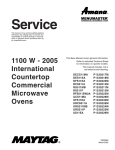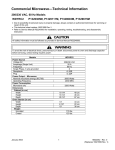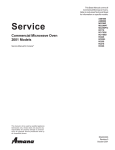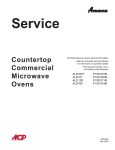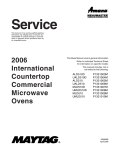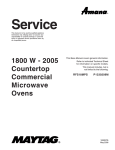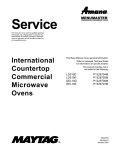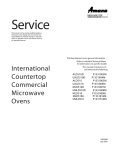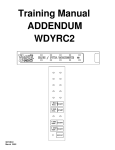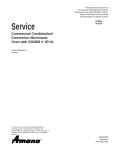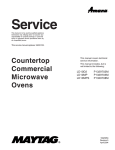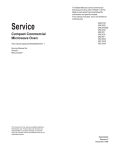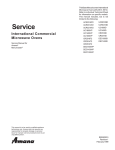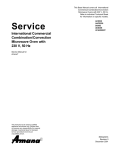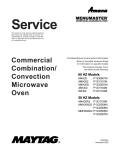Download Amana P1199604M Service manual
Transcript
This Base Manual covers International Commercial Microwave Ovens with 50 Hz. Refer to individual Technical Sheet for information on specific models. RC519M RC519M P1199603M P1199604M Service International Commercial Microwave Ovens Service Manual for Amana® This manual is to be used by qualified appliance technicians only. Amana does not assume any responsibility for property damage or personal injury for improper service procedures done by an unqualified person. RS5320014 Revision 0 July 2000 Important Information Pride and workmanship go into every product we produce to provide our customers with quality products. It is possible, however, that during its lifetime a product may require service. Products should be serviced only by a qualified service technician who is familiar with the safety procedures required in the repair and who is equipped with the proper tools, parts, testing instruments and the appropriate service manual. REVIEW ALL SERVICE INFORMATION IN THE APPROPRIATE SERVICE MANUAL BEFORE BEGINNING REPAIRS. Important Notices for Consumers and Servicers ! WARNING To avoid risk of serious injury or death, repairs should not be attempted by an unauthorized personnel, dangerous conditions (such as exposure to electrical shock) may result. ! CAUTION Amana will not be responsible for any injury or property damage from improper service procedures. If performing service on your own product, assume responsibility for any personal injury or property damage which may result. To locate an authorized servicer, please consult your telephone book or the dealer from whom you purchased this product. For further assistance, please contact: CONSUMER AFFAIRS DEPT. AMANA APPLIANCES, INC. AMANA, IOWA 52204 OR CALL 1-319-622-5511 or (1-800-843-0304) and ask for Consumer Affairs If outside the United States contact: AMANA ATTN: CONSUMER AFFAIRS DEPT AMANA, IOWA 52204, USA Telephone: (319) 622-5511 Facsimile: (319) 622-2180 TELEX: 4330076 AMANA CABLE: "AMANA", AMANA, IOWA, USA Recognize Safety Symbols, Words, and Labels ! DANGER DANGER - Immediate hazards which WILL result in severe personal injury or death. ! WARNING WARNING - Hazards or unsafe practices which COULD result in severe personal injury or death. ! CAUTION CAUTION - Hazards or unsafe practices which COULD result in minor personal injury or product or property damage. RS5320014 Rev. 0 2 Important Product Information ! ! WARNING WARNING To avoid risk of electrical shock, injury, or death, make sure these earthing instructions are followed. Precautions to be observed before and during servicing to avoid possible exposure to excessive microwave energy, or electrical shock disconnect power to oven. Earthing Instructions (A) Do not operate or allow oven to be operated with door open. ! (B) Make the following safety checks on all ovens to be serviced before activating the magnetron or other microwave source, and make repairs as necessary: WARNING Do not remove earthing prong when installing earthed appliance in a home or business that does not have three wire earthing receptacle, under no condition is earthing prong to be cut off or removed. It is the personal responsibility of the consumer to contact a qualified electrician and have properly earthed three prong wall receptacle installed in accordance with appropriate electrical codes • Interlock operation • Proper door closing • Seal and sealing surfaces (arcing, wear, and other damage) • Damage to or loosening of hinges and latches • Evidence of dropping or abuse (C) Before turning on microwave power for any service test or inspection within the microwave generating compartments, check the magnetron, waveguide or transmission line, and cavity for proper alignment, integrity, and connections. Should a two prong adapter plug be required temporarily, it is the personal responsibility of the consumer to have it replaced with properly earthed three prong receptacle or the two prong adapter properly earthed by a qualified electrician in accordance with appropriate electrical codes. (D) Any defective or misadjusted components in the interlock, monitor, door seal, and microwave generation and transmission systems shall be repaired, replaced or adjusted by procedures described in this manual before oven is released to the consumer. Servicing of Earthed Products The standard accepted color coding for earthing wires is GREEN or GREEN WITH YELLOW STRIPE. These earth leads are NOT to be used as current carrying conductors. It is extremely important that the technician replace any and all earths prior to completion of the service call. Under no condition should earth wire be left off causing a potential hazard to technicians and consumer. (E) Check microwave leakage to verify compliance with the federal performance standard should be performed on each oven prior to release to the consumer. Wiring Good service practice is to never route wiring over terminals and/or sharp edges. This applies to any wiring without regard to the circuit voltage. Wire insulation material and thickness is designed and regulated for electrical spacing purpose only, but cannot always be relied upon because of possible cuts and/or abrasions, which can occur during servicing. 3 RS5320014 Rev. 0 Table of Contents Microwave Energy Leakage Testing Equipment ............................................................... 27 Procedure For Measuring Radiation Leakage ........ 27 Measurement With the Outer Panel Removed ....... 27 Measurement With a Fully Assembled Oven .......... 27 Record Keeping and Notification After Measurement .............................................. 27 Troubleshooting Initial Power Up ....................................................... 28 Stand By Condition ................................................. 29 Cook Condition ....................................................... 30 Disassembly Procedures Latch Handle ........................................................... 31 Door ........................................................................ 31 Outer Door .............................................................. 31 Inner Door Ring Assembly ...................................... 31 Hinge ....................................................................... 31 Bottom Shelf ........................................................... 32 Grease Shield ......................................................... 32 Outer Case .............................................................. 32 Top Touch Panel Assembly ..................................... 32 Side Touch Panel Assembly .................................... 32 Low Voltage Circuit Board ....................................... 32 Top Antennas .......................................................... 33 Top Antenna Motor .................................................. 33 Antenna Matching ................................................... 33 Interlock Switch Assembly ...................................... 34 Top Rear Magnetron ............................................... 34 Top Front Magnetron ............................................... 34 Bottom Magnetron .................................................. 34 Installation ............................................................... 35 Magnetron and Control Thermal Protectors (TCO) . 35 Bottom Access Panel .............................................. 35 Bottom Stirrer Motor ................................................ 35 Bottom Antenna ...................................................... 35 Back Panel .............................................................. 36 Blower Wheel and Motor ......................................... 36 Fan Blade ................................................................ 37 H.V. Board ............................................................... 37 Cavity Thermal Protector (TCO) ............................. 37 Power Cord ............................................................. 37 Component Location ............................................... 37 Wiring Diagrams And Schematics ............................. 40 Important Information ................................................... 2 Important Product Information ...................................... 3 Important Safety Information ........................................ 5 Specification Information .............................................. 9 General Information Placement of the Oven ........................................... 10 Radio Interference .................................................. 10 Earthing Instructions ............................................... 10 Electrical Power Cord.............................................. 10 Operating Instructions Control Panel ........................................................... 11 Readout Display ....................................................... 11 Preprogrammed Pads ............................................. 12 Cook Levels and Hold ............................................. 12 Interrupting Operation ............................................. 12 Continuing after Pause............................................ 12 Cancelling Mistakes ................................................ 12 Operating Preprogrammed Pads ............................ 12 Variable Time Entry ................................................. 13 Changing Preset Number Pads .............................. 13 Programming Instructions Programming Multiple Stages ................................. 14 Programming Pause during Stage(s) ...................... 14 Programming Hold during Stage(s) ........................ 15 Deleting Cooking Stages ......................................... 15 Modifying User Time Limits ..................................... 15 Changing User Options ........................................... 16 Component Testing Procedures ................................. 17 Display Diagnostics Service Codes ......................................................... 21 S1 Watchdog - Membrane Touch Panel ................. 22 HOT Magnetron Overheating .................................. 22 CS Current Sense ................................................... 22 PCE1 Checksum..................................................... 23 PCE5 Communication Failure ................................. 23 PCE6 Communication Failure ................................. 23 HI High Line Voltage ............................................... 23 LO Low Line Voltage ............................................... 23 Service Test Accessing Service Test Mode ................................. 24 H.V. System Test ..................................................... 24 Diagnosing Individual H.V. System Components .... 24 Door Cycles and Magnetron Hours ......................... 25 Test Modes Power Test (Traditional Test Method) ...................... 26 Amana Appliances Inc. • 2800 220thTrail • Amana, Iowa • 52204 • Printed in the U.S.A. RS5320014 Rev. 0 4 3 Important Safety Information 5 RS5320014 Rev. 0 Important Safety Information RS5320014 Rev. 0 6 Important Safety Information 7 RS5320014 Rev. 0 Important Safety Information ! 7. In the area of the transformer, capacitor, diode, and magnetron there is HIGH VOLTAGE. When the unit is operating, keep this area clean and free of anything which could possibly cause an arc or earthing, etc. 8. Do not for any reason defeat the interlock switches. There is no valid reason for this action at any time; nor will it be condoned by Amana. 9. IMPORTANT: Before returning a microwave to a customer, check for proper switch interlock action. The primary and secondary switches MUST open when the door is actuated. The monitor switch MUST close at a 1/4" when the door is opened. 10.Before returning a microwave to a customer, verify the door spacing is reasonably uniform along the top, bottom, and sides, and that it measures 1/8" or less. 11. The Amana microwave oven should never be operated with: • Any components removed and/or bypassed. • Any of the safety interlocks found to be defective. • Any of the seal surfaces defective, missing, or damaged. 12.To ensure that the unit does not emit excessive microwave leakage and to meet the Department of Health Human Service guidelines, check the oven for microwave leakage using Narda Model 8110B, or Holaday HI1501, HI1510, HI1710 leakage monitor as outlined in the instructions. The maximum leakage level allowed is 4mW/cm2. 13.If servicer encounters an emission reading over 4 mw/cm2 the servicer is to cease repair and contact the Amana Service Department immediately for further direction. Amana Appliances will contact the proper Government Agency upon verification of the test results. CAUTION Read the following information to avoid possible exposure to microwave radiation: The basic design of the Amana or Menumaster microwave ovens make it an inherently safe device to both user and servicer. However, there are some precautions which should be followed when servicing the microwave oven to maintain this safety. These are as follows: 1. Always operate the unit from an adequately earthed outlet. Do not operate on a two-wire extension cord. 2. Before servicing the unit (if unit is operable), perform the microwave leakage test. 3. The oven should never be operated if the door does not fit properly against the seal, the hinges or hinge bearings are damaged or broken; the choke is damaged, (pieces missing, etc.); or any other visible damage can be noted. Check the choke area to ensure that this area is clean and free of all foreign matter. 4. If the oven operates with the door open and produces microwave energy, take the following steps. A. Tell the user not to operate the oven. B. Contact Amana Appliances immediately. 5. Always have the oven disconnected when the outer case is removed except when making the "live" tests called for in this Service Manual. Do not reach into the equipment area while the unit is energized. Make all connections for the test and check them for tightness before plugging the cord into the outlet. 6. Always earth the capacitors on the magnetron filter box and H. V. Capacitor with an insulated-handle screwdriver before working in the high voltage area of the equipment compartment. Some types of failures will leave a charge in these capacitors and the discharge could cause a reflex action which could make you injure yourself. RS5320014 Rev. 0 8 Specifications F eat u r es RC519MP Air Filter Removable, located front grille at bottom of unit. Timing Programmable touch control with digital display - electronic. Number of Magnetrons 3 End of Cycle Indication Visual display and electronic tone. F r eq u en c y 2450 MHz C o o k i n g P o w er IEC 705 Test Method 1900 Watts Nominal Traditional Test Method 1600 Watts Nominal P o w er R eq u i r em en t s Phase 50 Hz Single Phase Input Power 2900 Watts Electrical Ratings 230 Vac Ov en In t er io r Dim en s io n s Height 8 3/4 inches / 22.2 cm Width 13 3/16 inches / 33.5 cm Depth - (with door closed) 14 7/8 inches / 37.7 cm Volume 1 cu. ft. / 28 liters E x t er i o r D i m en s i o n s Height - Overall 18 inches / 45.8 cm Width 19 1/4 inches / 48.9 cm Depth - (overall) 25 3/8 inches / 64.5 cm Shipping Weight 119 lbs. / 54.0 kg Uncrated 94 lbs. / 42.63 kg 9 RS5320014 Rev. 0 General Information Placement of the Oven Earthing Instructions Do not install microwave next to or above source of heat, such as a deep fat fryer. This could cause the microwave to operate improperly and could shorten the life of electrical components. This appliance MUST be earthed. If an electrical short circuit occurs, earthing reduces risk of electric shock by providing an escape wire for the electric current. The cord for this appliance has an earthing wire with an earthing plug. Place the plug into an outlet that is properly installed and earthed. Do not use a two–prong adapter. Install microwave on a level countertop surface. Do not block or obstruct oven filter. Allow access for cleaning. All air vents must be kept clear during cooking. If air vents are covered during operation the oven may overheat. In this case, a sensitive thermal safety device automatically turns the oven off. The oven will be inoperable until the oven has cooled sufficiently. ! WARNING To avoid risk of electric shock, personal injury or death, do not alter the plug and use earthing plug properly. Consult a qualified electrician if you do not understand the earthing instructions or if you wonder whether the appliance is properly earthed. Keep the electrical power cord dry and do not pinch or crush it in any way. B The wires in the power cord are colored in accordance with the following code: A • Green/Yellow: • Blue: • Brown: C Earth Neutral Live If oven main lead wire colors do not correspond with terminal plug markings or colors, match plug terminals according to following markings: • E—Earth • N—Neutral • L—Live Electrical Power Cord A–Allow at least 3.81 cm (1-1/2") of clearance around sides of unit. B–Allow at least 3.81 cm (1-1/2") of clearance on top unit. C–Allow at least 6.5 cm (2-1/2") of clearance between air discharge on back of unit and back wall. Receptacle Plug Radio Interference Microwave oven operation may cause interference to radio, television, or similar equipment. Reduce or eliminate interference by doing the following: • Clean the door and sealing surfaces of microwave oven according to instructions in “Care and Cleaning” section. • Place radio, television, etc. as far as possible from the microwave oven. • Use a properly installed antenna on radio, television, etc. to obtain stronger signal reception. RS5320014 Rev. 0 Equipment requires a 230 VAC, 50 Hz, 16 amp power supply Do not use a extension cord. If the product power cord is too short, have a qualified electrician install a three-prong receptacle. This unit should be plug into a separate 230 VAC / 50 Hz power supply. If other equipment is on the same circuit, an increase in cooking times may be required and fuse can be blown. 10 Operating Instructions MENU 1 MENU 2 ADD PAUSE POWER LEVEL Hidden Enable Pad QUANTITY DELETE STATUS Control Panel Pads MENU 1 or MENU 2 Use for independent cooking programs. ADD Use to make a change to preset number pads. PAUSE Use to interrupt microwave operation halfway through cooking stage. Manipulate food during pause. Not available during Variable Time Entry cooking. POWER LEVEL Use to select power level. If no power level is selected, oven operates at 100 percent power. QUANTITY Use to select a quantity greater than one. DELETE Use to delete preprogrammed number pads, current heating stages, and power levels. STATUS Use in optional programming to change options. Press to move through stages 1–4 of programming. HOLD Use to operate oven with no microwave energy for programmed time. TIME ENTRY Use to bypass preset number pads. Pads 1–0 Use to start a cooking sequence for preset programs. Press pads (press directly on number) for Variable Time Entry and reduced power cooking. TIME ENTRY READOUT DISPLAY HOLD Readout Display “EOC” (End of Cycle) Lights at end of cooking cycle. “PAUS” (Pause) indicator Lights during cooking pause. “P” Displays at programming entry point when programming mode is entered. Lights when viewing stage with an enabled pause. “POWER” Lights when microwave energy is generated. “COOK LEVEL” Lights when viewing stage with reduced power or hold. Power level digit or “H” for hold displays. “MENU 1” or “MENU 2” Lights active menu. “ITEM” Flashes when pads accept entries. Lights when number is pressed to select item. “LMT” (Limit) Flashes when either user time limit or maximum time limit is exceeded. “QTY” (Quantity) After QUANTITY pad is pressed, indicator flashes until desired quantity is entered or 15 second time limit expires. Shows during cooking cycle when quantity greater than one is selected. “STG” (Stage) Lights when multiple cooking stages exist for the selected item. START Use to start Variable Time Entry program or restart interrupted cooking cycle. STOP/RESET Use to exit programming mode and stop cooking during cooking cycle. 11 RS5320014 Rev. 0 Operating Instructions Preprogrammed Pads Continuing after Pause Oven contains two menus with 10 preset number pads each. Heating times and power levels can be adjusted to fit menu requirements. If oven is programmed to pause in middle of cooking cycle, oven signals 3 times and shows “PAUS”. When oven pauses, open door, manipulate food, close door, and press START pad to continue operation. Number pads come preprogrammed from factory to operate at full power for following times. MENUS 1 and 2 pads are programmed identically at factory. • If oven fan is operating during pause, press START pad to resume operation, without opening oven door or manipulating food. • If oven fan is not operating during pause, open oven door and press START pad to resume operation. Pad Cooking Time 1 10 seconds Cancelling Mistakes 2 20 seconds 3 30 seconds 4 45 seconds • If oven is not operating, press RESET pad to clear display. • If oven is operating, press RESET pad once to stop oven, then again to clear display. 5 1 minute 6 1 1/2 minutes 7 2 minutes 8 3 minutes 9 4 minutes 10 5 minutes Operating Preprogrammed Pads 1. Open oven door and place food in oven. Display shows “door”. • Fan and light operate. 2. Close oven door. Display shows “MENU” and “ITEM” flashes. • If oven display does not show “ITEM”, pads do not except entries. Open and close oven door or press STOP/RESET pad to activate pads. 3. Press desired menu pad if different than display. 4. Press QUANTITY pad to increase quantity if greater than 1. • Cooking times are calculated automatically. 5. Press desired number pad and oven operates. • Display shows item selected and heating time counts down. • Display shows “POWER” when microwave energy is present. 6. Oven stops and signal sounds when timing sequence is finished. • Display shows "EOC". 7. Open oven door. Instructions are written for factory programmed ovens. Ovens that are reprogrammed may respond differently than described below. Cook Levels and Hold Set oven to cook using between 10 and 100 percent cooking power. If food requires time between cooking cycles without microwave energy, use HOLD pad. When HOLD pad is used, oven operates for cooking stage without producing microwave energy. Interrupting Operation Summary of Operating Preprogrammed Pads 1. Open oven door and place food in oven. 2. Close oven door. 3. Press QUANTITY pad if desired quantity is greater than one. 4. Enter desired item number. 5. At end of cycle, open oven door. • Open oven door to interrupt operation. Blower continues to operate. Close door and press START pad to resume oven operation and countdown timing. If preset pad is pushed immediately after door is opened and closed, a slight delay occurs before oven starts and timing countdown begins. • Press RESET pad to interrupt operation. Display continues to show countdown time. Press START pad to resume oven operation and countdown timing. RS5320014 Rev. 0 12 Operating Instructions Variable Time Entry Changing Preset Number Pads 1. Open oven door and place food in oven. Display shows “door”. Fan and light operate. 2. Close oven door. Display shows “MENU” and “ITEM” flashes. • If oven display does not show “ITEM”, pads do not except entries. Open and close oven door or press STOP/RESET pad to activate pads. 3. Press TIME ENTRY pad. Display shows “0000”. 4. Press number pads to enter desired cooking time. 5. Press POWER LEVEL pad if power level other than 100 percent is required. Display shows “COOK LEVEL” and current power level if other than 100 percent power. 6. Press number pad to enter desired power level. For example, pressing 2 pad is 20 percent power. 7. Press START pad and oven operates. Display shows “POWER” when microwave energy is present. If power level other than 100 percent power was programmed, display shows “COOK LEVEL” and power level. Display counts down cooking time. 8. Oven stops and signals when timing sequence is finished. Display shows “EOC”. 9. Open oven door and remove food. 1. Open oven door. Display shows “door”. • If door is closed or RESET pad is pressed before finishing programming sequence, oven exits programming mode. 2. Press pad 1 for five seconds. After five seconds, signal sounds. Display shows “P” and active menu. 3. Press ADD pad. 4. Press desired menu pad. Display shows active menu. 5. Press desired number pad. Display shows selected number pad, “ITEM”, heating time, “COOK LEVEL” and power level (if other than 100 percent power) for stage one. • If multiple stages exist, display shows “STG” and number of programmed stages. 6. Press number pads to enter desired cooking time. 7. Press POWER LEVEL pad if power level requires change. Display shows “COOK LEVEL” and current power level (if other than 100 percent power). 8. Press number pad to enter desired power level. Display shows new power level (if other than 100 percent power). For example, pad 2 is 20 percent power. 9. Press START pad to enter new heating time and power level in oven memory. Display shows “P”. 10.Press RESET pad or close oven door to exit programming mode. Summary of Variable Time Entry 1. Open oven door and place food in oven. 2. Close oven door. 3. Press TIME ENTRY pad. 4. Enter desired cooking time. If 100 percent power is desired, proceed to step 7. 5. Press POWER LEVEL pad. 6. Enter desired power level. 7. Press START pad. 8. At end of cycle, open oven door. Summary of Changing Preset Number Pads 1. Open oven door. 2. Press pad 1 for five seconds. 3. Press ADD pad. 4. Press desired menu pad. 5. Press desired number pad. 6. Enter desired cooking time. 7. Press POWER LEVEL pad if power level other than 100 percent is desired. Enter desired power level. 8. Press START pad. 9. Press RESET pad or close oven door. 13 RS5320014 Rev. 0 Programming Instructions Programming Multiple Stages Programming Pause during Stage(s) 1. Open oven door. Display shows “door”. • If door is closed or RESET pad is pressed before finishing programming sequence, oven exits programming mode. 2. Press pad 1 for five seconds. After five seconds, signal sounds. Display shows “P” and active menu. 3. Press ADD pad. 4. Press desired menu pad. Display shows active menu. 5. Press desired number pad. Display shows selected number pad, “ITEM”, heating time, “COOK LEVEL” and power level (if other than 100 percent power) for stage one. • If multiple stages exist, display shows “STG” and number of programmed stages. 6. Press number pads to enter desired cooking time. 7. Press POWER LEVEL pad if power level requires change. Display shows “COOK LEVEL” and current power level (if other than 100 percent power). 8. Press number pad to enter desired power level. Display shows new power level if other than 100 percent power. For example, pad 2 is 20 percent power. 9. Press STATUS pad to advance to next stage. Display shows “P(1-4)” for one second followed by time and power level (if other than 100 percent power) for selected stage. • “P” represents program and is followed by current stage. 10.Repeat steps 6–9 for additional stages. 11. Press START pad to enter new heating time and power level in oven memory. Display shows “P”. 12.Press RESET pad or close oven door to exit programming mode. Pause cooking during each or any stage to manipulate food. Pause occurs halfway through stage. 1. Open oven door. Display shows “door”. • If door is closed or RESET pad is pressed before finishing programming sequence, oven exits programming mode. 2. Press pad 1 for five seconds. After five seconds, signal sounds. Display shows “P” and active menu. 3. Press ADD pad. 4. Press desired menu pad. Display shows active menu. 5. Press desired number pad. Display shows selected number pad, “ITEM”, heating time, “COOK LEVEL” and power level (if other than 100 percent power) for stage one. • If multiple stages exist, display shows “STG” and number of programmed stages. 6. Press number pads to enter desired cooking time. 7. Press POWER LEVEL pad if power level requires change. Display shows “COOK LEVEL” and current power level if other than 100 percent power. 8. Press number pad to enter desired power level. Display shows new power level if other than 100 percent power. For example, pad 2 is 20 percent power. 9. Press PAUSE pad. • Press STATUS pad and repeat steps 5–9 for additional stages. 10.Press START pad to enter new heating time and power level in oven memory. Display shows “P”. 11. Press RESET pad or close oven door to exit programming mode. Summary of Programming Multiple Stages 1. Open oven door. 2. Press pad 1 for five seconds. 3. Press ADD pad. 4. Press desired menu pad. 5. Press desired number pad. 6. Enter desired cooking time and power level. 7. Press PAUSE pad. 8. Press START pad. 9. Press RESET pad or close oven door. Summary of Programming Multiple Stages 1. Open oven door. 2. Press pad 1 for five seconds. 3. Press ADD pad. 4. Press desired menu pad. 5. Press desired number pad. 6. Enter desired cooking time and power level if power level other than 100% is desired. 7. Press STATUS pad. 8. Enter desired cooking time and power level. 9. Repeat steps 6–9 for additional stages. 10.Press START pad. 11. Press RESET pad or close oven door. RS5320014 Rev. 0 14 Programming Instructions Programming Hold during Stage(s) Deleting Cooking Stages Hold food without microwave power during one or any stage. 1. Open oven door. Display shows “door”. • If door is closed or RESET pad is pressed before finishing programming sequence, oven exits programming mode. 2. Press pad 1 for five seconds. After five seconds, signal sounds. Display shows “P” and active menu. 3. Press desired number pad to be deleted. 4. Press DELETE pad twice. All cooking stages and power levels for this item are set to zero. Display shows “P”. 5. Press RESET pad or close oven door to exit programming mode. 1. Open oven door. Display shows “door”. • If door is closed or RESET pad is pressed before finishing programming sequence, oven exits programming mode. 2. Press pad 1 for five seconds. After five seconds, signal sounds. Display shows “P” and active menu. 3. Press ADD pad. 4. Press desired menu pad. Display shows active menu. 5. Press desired number pad. Display shows selected number pad, “ITEM”, heating time, “COOK LEVEL” and power level (if other than 100 percent power) for stage one. • If multiple stages exist, display shows “STG” and number of programmed stages. 6. Press number pads to enter desired hold time. 7. Press POWER LEVEL pad. 8. Press HOLD pad. • Press STATUS pad and repeat steps 6–9 of Programming Multiple Stages section for additional stages. 9. Press START pad to enter new time and power level in oven memory. Display shows “P”. 10.Press RESET pad or close oven door to exit programming mode. Summary of Deleting Cooking Stages 1. Open oven door. 2. Press pad 1 for five seconds. 3. Press desired menu pad. 4. Press desired number pad to be deleted. 5. Press DELETE pad twice. 6. Press RESET pad or close oven door. Modifying User Time Limits A user defined time can limit each set of programs associated with each available menu pad. For example, if user time limit for MENU 1 is 30 minutes, total cook time of all available stages for a single number pad can not exceed 30 minutes. 1. Complete steps 1–3 of Changing User Options . 2. Press desired menu pad to change. Display shows active menu and present user time limit. 3. Press numbers to enter desired user time limit. Display shows new user time limit. 4. Press corresponding menu pad again to save user time limit. For example, if changing heating time limit for MENU 1, press MENU 1 pad. 5. Press RESET pad or close oven door to exit programming mode. Summary of Programming Multiple Stages 1. Open oven door. 2. Press pad 1 for five seconds. 3. Press ADD pad. 4. Press desired menu pad. 5. Press desired number pad. 6. Enter hold time. 7. Press POWER LEVEL pad. 8. Press HOLD pad. 9. Press START pad. 10.Press RESET pad or close oven door. Summary of Modifying User Time Limits 1. Open oven door. 2. Press pad 1 for five seconds. 3. Press hidden enable pad. 4. Press desired menu pad to change. 5. Enter desired heating time limit. 6. Press corresponding menu pad. 7. Press RESET pad or close oven door. 15 RS5320014 Rev. 0 Programming Instructions Summary of Optional Programs 1. Open oven door. 2. Press 1 pad for five seconds. 3. Press hidden enable pad. 4. Press START pad to review options. 5. Press STATUS pad to change option. 6. Repeat steps 4–5 to change additional options. 7. Press hidden enable pad to return to programming mode. 8. Press RESET pad or close oven door. Changing User Options 1. Open oven door. Display shows “door”. • If door is closed or RESET pad is pressed before finishing programming sequence, oven exits programming mode. 2. Press pad 1 for five seconds. After five seconds, signal sounds. Display shows “P” and active menu. 3. Press hidden enable pad. Locate hidden enable pad to immediate left and slightly down from MENU 1 pad. Displays shows “OP:1(1-3)”. • ”OP” represents optional program mode, first number represents option number and second number represents functions currently selected for option. 4. Press START pad to advance to other options. See table for options. Option End-of-cycle signal tone Tone when pad is pressed Control panel resets when door is opened End-of-cycle signal User time limit Description Code Off OP:10 Continuous tone* OP:11 5 continuous tones OP:12 5 tones, 5 cycles OP:13 Off OP:20 On* OP:21 Off* OP:30 On OP:31 Loud* OP:40 Medium OP:41 Off OP:50 On* OP:51 *As shipped from factory 5. Press STATUS pad to change option. Press START pad to save changes. 6. Repeat steps 4–5 to change additional options. 7. Press hidden enable pad to return to programming mode. Press RESET pad or close oven door to exit programming mode. RS5320014 Rev. 0 16 Component Testing Procedures ! WARNING To avoid risk of electrical shock, personal injury, or death, disconnect power to oven and discharge capacitor before servicing, unless testing requires it. Illustration Component Thermal Cutout B5795306 .............. B5684118 .............. B5684106 .............. Diode Assembly B8383102 Testing Disconnect all wires from TCO. Measure resistance across terminals. Cavity Thermal Fuse ................................ Control TCO ............................................. Magnetron TCO ....................................... Discharge Capacitors Remove diode lead from capacitor and connect ohmmeter. D7681501 Triac NOTE: Analog meter must contain a battery of 6 volts minimum. Caution - Do not operate oven with wire to terminal MT2 removed. Infinite Approximately 40 Ω or more Infinite Infinite Capacitor Measure resistance from: MT1 to MT2 MT1 to Gate MT2 to Gate All terminals to ground Discharge Capacitors GA TE 12548808 Open at 262°F (128°C) Open at 280°F and closed at 180°F Open at 280°F and closed at 180°F Infinite resistance should be measured in one direction and 50KΩ or more in the opposite direction. Reverse leads for second test. Disconnect wires to triac. MT2 MT1 Results Remove wires from capacitor terminals and connect ohmmeter, set on highest resistance scale to terminals. Between Terminals: Meter should momentarily deflect towards zero then return to over 5 MΩ. IF no deflection occurs, or if continuous deflection occurs, replace capacitor. Terminal to Case: Infinite resistance 10172901Q Snubber Assembly Also check between each terminal and capacitor case. Disconnect wires to snubber. D7831006 Magnetron Measure resistance across terminals. Discharge Capacitors Infinite Between Terminals: Less than 1 Ω Remove wires from magnetron and connect ohmmeter to terminals. Also check between each terminal and ground. Each terminal to ground measures Infinite resistance. Note: This test is not conclusive. If oven does not heat and all other components test good replace the magnetron and retest. 10773303 Blower Motor 10976702 Line Line filter Load Earth Wire Harness Remove all wires from motor. Measure resistance across coil. Approximately 30 Ω Line to Line Load to Load Line to Load Any terminal to Earth .8 M Ω .8 M Ω Continuity Infinite Test continuity of wires. Indicates continuity 17 RS5320014 Rev. 0 Component Testing Procedures ! WARNING To avoid risk of electrical shock, personal injury, or death, disconnect power to oven and discharge capacitor before servicing, unless testing requires it. Illustration C8901508 Component Auto transformer 240 240 220 220 120 COM COM 10788609 Transformer 6 5 5 COM 4 TCO 6 COM 230 220 220 230 R0150102 Testing Discharge Capacitor Remove all wires from terminals, and measure resistance from: 220 to 0 240 to 0 220 to 240 240 to earth 220 to earth 0 to earth Discharge Capacitor Remove all wires from terminals, and measure resistance from: 220 to Common 230 to Common Terminal 5 to 6 Terminal 4 to Earth screw on transformer Terminal 4 to any other terminal 4 Antenna motor Interlock switch Type 1 This transformer is equipped with a 155°C thermal cutout Approximately 1.3 Ω Approximately 1.3 Ω <1 Ω 70 Ω Infinite resistance should be indicated, if not replace transformer. Approximately 10 KΩ Disconnect wires to switch Doo r O pe n D um my Approximately 55 ohms. Approximately 55 ohms. Approximately 1.5 ohms. Infinite Infinite Infinite. Remove all wires from motor. Measure resistance across terminals. R0150155 Results 1 2 Se condary 3 With door open measure resistance from: Terminal 2 to terminal 3 Terminal 4 to terminal 5 Terminal 7 to terminal 8 Infinite Ω Infinite Ω Indicates continuity With door closed measure resistance from: Terminal 2 to terminal 3 Terminal 4 to terminal 5 Terminal 7 to terminal 8 Indicates continuity Indicates continuity Infinite Ω 4 Lo gic/Primary 5 6 7 M onito r 8 9 12360503 Interlock switch assembly Type 2 Disconnect wires to switch. Door closed 7 8 4 5 2 3 5 4 7 8 With door open measure resistance from: Terminal 2 to 3 Secondary Terminal 4 to 5 Primary Terminal 7 to 8 Monitor Infinite Infinite Indicates continuity With door closed measure resistance from: Terminal 2 to 3 Secondary Terminal 4 to 5 Primary Terminal 7 to 8 Monitor Indicates continuity Indicates continuity Infinite 2 3 RS5320014 Rev. 0 18 Component Testing Procedures ! WARNING To avoid risk of electrical shock, personal injury, or death, disconnect power to oven and discharge capacitor before servicing, unless testing requires it. Illustration 10763208 Component High voltage board J6 connections 1−White 2−Open 3−Red 4−Open 5−Yellow 6−Orange Pin #1 J1 J2 Testing Connector Plugged-In J2Pin 5 (violet) to ground J2Pin 6 J2Pin 7 (blue) to ground Results −27 VDC Ground +18 VDC J6Pin 1 (white) to Pin 3 (red) 240 voltsoutput to blower and antenna motors when line voltage is 240 V 220 voltsoutput to auto transformer for blower and antenna motors when line voltage is 220 V Line voltage Connector Plugged-In J2Pin 5 (violet) to ground J2Pin 6 J2Pin 7 (blue) to ground −27 VDC Ground +18 VDC J6Pin 6 (orange) to Pin 1 (white) J6Pin 5 (yellow) to Pin 1 (white) E1 J4 White Red Yellow Orange E3 E2 J3 J5 12261708 Low voltage board 1 J2 J1 J3 1 1 1 J6 1 J5 J4 J3 connector is for lower keyboard ribbon. J4 connector is for upper keyboard ribbon. 19 RS5320014 Rev. 0 Component Testing Procedures ! To avoid risk of electrical shock, personal injury, or death, disconnect power to oven and discharge capacitors before servicing, unless testing requires it. WARNING Top Touch Panel Keypad Menu 4/Quantity Menu 3 Ribbon Trace 11 Ribbon Trace 10 Keypad 11 8* \ 3** Pow er Level Time Entry operation: Pause 10 5 Hold 1. Identif y ribbon traces To test touch panel for proper Ribbon Trace 9 Ribbon Trace 5 8 7 7 6 Delete 10 4 Enable 7 5 for selected touch panel Status 10 3 Add 4* \ 5** 3* \ 4** using chart. Menu 1 9 8 Menu 2 9 7 Ribbon Trace 7 10 2. Resistance betw een selected traces = 0 ohms. * = P1199603M 3. Pressing touch panel, ** = P1199604M resistance betw een selected traces is less than 60 ohms. 4. With touch panel pressed resistance from both traces to traces 1 & 2 should be about 0 ohms. Ribbon Cable Side Touch Panel Stop/Reset Ribbon Trace 3* \ 1** Ribbon Trace 4* \ 2** 6 Ribbon Trace 6 0 4 5 7 6 Start 4 10 4 7 8 8 5 6 5 7 10 9 5 10 2 8 9 3 8 10 1 9 10 Keypad * = P1199603M Keypad ** = P1199604M To test touch panel for proper operation: 1. Identif y ribbon traces for selected touch panel using chart. 2. Resistance betw een selected traces = 0 ohms. 3. Pressing touch panel, resistance betw een selected traces is less than 60 ohms. 4. With touch panel pressed resistance from both traces to traces 11 &12 Ribbon Cable should be about 0 ohms. RS5320014 Rev. 0 20 Display Diagnostics ! CAUTION All repairs as described in this troubleshooting guide section are to be performed only after the caution procedures one through six listed below have been followed. 1. Check earthing before checking for trouble. 2. Be careful of the high voltage circuit. 3. Discharge high voltage capacitor. 4. When checking the continuity of the switches or the high voltage transformer, disconnect one lead wire from these parts and then check continuity with the AC plug removed. To do otherwise may result in a false reading or damage to your meter. 5. Do not touch any parts of the circuitry on the P.C. Board circuit since static electric discharge may damage this control panel. Always touch yourself to earth while working on this panel to discharge any static charge in your body. 6. 220/240 Vac is present in the high voltage board terminals of power relay and primary circuit of low voltage transformer. 7. When troubleshooting, be cautious of possible electrical hazard. Service Codes During operation, the display may show the following service codes: Service Codes Explanation S1 Watchdog - Membrane Touch Panel CS Current Sense FL Low Current FH High Current PL Power Level PCE1 Checksum - Check Permanent Memory PCE5 Communication Failure PCE6 Communication Failure HOT Magnetron Overheating HI High Line Voltage LO Low Line Voltage 21 RS5320014 Rev. 0 Display Diagnostics S1 Watchdog - Membrane Touch Panel CS Current Sense Watchdog circuit verifies touch panel entry. Possible Causes: 1. Shorted top touch panel. 2. Shorted side touch panel. Testing 1. Disconnect power from oven. 2. Disconnect one touch panel ribbon cable from the L.V. circuit board. 3. Plug oven in, open and close door to activate oven. 4. Wait approximately 60 seconds. If "S1" does not appear in display, replace the disconnected touch panel. 5. If "S1" re-appears in display, disconnect the other touch panel and repeat steps 3 and 4. HOT Magnetron Overheating Current Sense – Indicates control is sensing low current (Amp) draw. Check components which would allow unit to run but produce no heat or low heat. Current sense circuit is active only when using pre-programmed pads. Time Entry feature will by-pass current sense circuit. Red wire from cavity T.C.O. must be routed through current sense loop on H.V. Board. Possible Causes: 1. Interlock switch (contacts 2 & 3). 2. Open thermal cut-out (magnetron). 3. Open/loose wire. 4. Power relay. 5. H.V. Board. 6. Magnetron. 7. Diode. 8. Capacitor. 9. Transformer. 10.Triac. Red Wire to Cavity TCO When "HOT" is displayed, the blower motor should be operating. Possible Causes: 1. Restricted air filter. 2. High ambient temperature. 3. Oven operated empty or with light loads. 4. Open control TCO. 5. Inoperative blower motor/wheel. 6. Open/loose TCO ground wire. 7. Open/loose E1 ground wire at H.V. board. 8. Inoperative high voltage board. RS5320014 Rev. 0 Current Sense Loop High Voltage Board 22 Display Diagnostics PCE1 Checksum PCE6 Communication Failure NOTE: Before scheduling service for this complaint, instruct customer to unplug oven for one minute, reconnect, and retest. If unit operates properly, no further service is required. NOTE: Before scheduling service for this complaint, instruct customer to unplug oven for one minute, reconnect, and retest. If unit operates properly, no further service is required. If this error code does not disappear possible causes are: If this error code does not disappear possible causes are: 1. Broken or improper wire connection between high voltage board and low voltage board. 2. Inoperative cable between low voltage board and extended memory board. 3. Inoperative high voltage board. 4. Inoperative low voltage board. 5. Inoperative extended memory board. 1. Inoperative low voltage board. PCE5 Communication Failure HI High Line Voltage NOTE: Before scheduling service for this complaint, instruct customer to unplug oven for one minute, reconnect, and retest. If unit operates properly, no further service is required. If this error code does not disappear possible causes are: 1. Input voltage over 270 VAC. 2. Inoperative high voltage board. 1. Broken or improper wire connection between high voltage board and low voltage board. 2. Inoperative cable between low voltage board and extended memory board. 3. Inoperative high voltage board. 4. Inoperative low voltage board. 5. Inoperative extended memory board. LO Low Line Voltage 1. Input voltage less than 185 VAC. 2. Inoperative low voltage board. 23 RS5320014 Rev. 0 Service Test The high voltage portion of these models contain multiple H.V. systems. Each H.V. System contains the following: • 1 Magnetron • 1 H.V. Transformer • 1 Capacitor • 1 Diode • 1 Triac • Connecting wiring Each H.V. system may be operated independently for diagnostic purposes. H.V. System Test When Service Test Mode has been accessed, the H.V. system test must be started within 60 seconds to assure accurate test readings. The door must be closed. 1. Press pad 1 to activate H.V. System # 1. • The triac drive will be activated after a minimum of 100 milliseconds. • A 62 seconds full power cook cycle will begin for the selected H.V. system. Amount of Time Current During this test the display will show a number (usually between 8 and 24 for each H.V. system operating) signifying some current draw of the unit. H.V. System Will Operate reference POWER This is not showing actual amperage, but a current reference. Accessing Service Test Mode H.V. System 1 1. Open door and place 1000 ml water load in oven. H.V. System 2 NOTE: Perform the following 4 steps within 15 seconds or this procedure will be cancelled. 2. 3. 4. 5. Press DELETE, Press 1, 3, 5, 7. Close door. Press DELETE. NOTE: Pressing RESET at any time will cause the control to exit the Service Test. Current reference Indicates Power Relays are closed for the Service Mode Test H.V. System 3 Display with H.V. System # 1 Activated 2. 3. 4. 5. 6. Press pad 1 again to de-activate H.V. System # 1. Press pad 2 to activate H.V. System # 2. Press pad 2 again to de-activate H.V. System # 2. Press pad 3 to activate H.V. System # 3. Press pad 3 again to de-activate H.V. System # 3. Diagnosing Individual H.V. System Components If the service test indicates a non-functional H.V. system, proceed as follows: 1. Identify the number of the H.V. system that is not functioning and the corresponding magnetron location. MENU 1 = Bottom magnetron MENU 2 = Top rear magnetron MENU 3 = Top front magnetron Indicates Voltage is Greater than 218 VAC Initial Display in Service Test Mode RS5320014 Rev. 0 NOTE: Component numbering in the wiring/schematic diagrams may not match the numbering of MENU 1, MENU 2 or MENU 3 display indicators. 2. Using the wiring diagram, identify the location of components numbered the same as the nonfunctioning magnetron. H.V. components with the same number are part of the same H.V. system. 24 Service Test Multiple H.V. System Testing Two or three H.V. Systems may be tested together. Below are display samples showing different combinations. Door Cycles and Magnetron Hours • Press TIME ENTRY pad once for door cycles. NOTE: Door cycle counter advances one number for every 100 door cycles. NOTE: This is not showing actual amperage, but a current reference. Example: Display reads 156 x 100 = 15,600 (Actual door cycles) Example: If one H.V. System is showing a current reading of 15, then any two H.V. Systems may have a reading of about 30, and all three H.V. Systems may have a reading of about 45. Current reference readings will vary. MENU1 • Press TIME ENTRY pad again for H.V. section # 1 hours. • Press TIME ENTRY pad again for H.V. section # 2 hours. • Press TIME ENTRY pad again for H.V. section # 3 hours. • Press TIME ENTRY pad again reverts to door cycles. MENU2 Door Cycles H.V. System 1 & 2 Number of Door Cycles MENU1 MENU3 H.V. System 1 & 3 Display MENU1 MENU2 MENU3 H.V. System 1 , 2, & 3 Magnetron Hours Magnetron Hours Indicates Operating H.V. System Display 25 RS5320014 Rev. 0 Test Modes Power Test (Traditional Test Method) Test equipment required is Amana power test kit R0157397 (Fahrenheit), or Menumaster power test kit M95D5 (Celsius). 1. Fill the plastic container to the 1000 ml. line with cool tap water. 2. Using the thermometer; stir the water, measure, and record the water temperature. Initial water temperature should be approximately 60 °F (16 °C). 3. Place container on the center of the oven shelf and heat the water for 33 seconds for ovens with more than 1550 watts or 63 seconds for ovens with less than 1550 watts. NOTE: Use a watch second hand, not the oven timer. 4. Stir the water, measure and record the temperature of the water after heating time is complete. 5. Subtract the starting water temperature (Step 2), from the ending water temperature (Step 4) to obtain the temperature rise (∆T). 6. See the Traditional Power Test Temperature Chart below. NOTES: •The IEC-705 test method requires precision measurements and equipment. It is not practical to perform the IEC test in the field. To convert the traditional power test results to the approximate IEC-705 rating, take the traditional power test results and add 100 watts per magnetron for the unit being tested. Example: 1550 watts output using the traditional power test for model RC519MP + 300 watts (3 magnetrons X 100 watts) 1850 Approximate IEC-705 results •Always perform power test three times for accuracy, changing the water after each test is performed. •Variation or errors in the test procedure will cause a variance in the temperature rise. Additional power tests should be made if temperature rise appears marginal. •Low line voltage will cause lower temperature rise. Traditional Power Test Temperature Chart THIRTY THREE (33) SECONDS run time chart for units more than 1550 Watts cooking power ∆T (°F) Cooking Power Output ∆T Cooking (°F) Power Output ∆T (°C) Cooking Power Output ∆T (°C) 17 18 19 20 21 22 1319 1395 1472 1550 1627 1705 23 24 25 26 27 9.5 10.5 10.5 11 11.5 12 1330 1400 1470 1540 1610 1680 12.5 13 13.5 14 14.5 15 ∆T (°F) 18 19 20 21 22 23 24 25 26 27 28 SIXTY-THREE (63) SECONDS run time chart for units less than 1550 Watts cooking power ∆T ∆T ∆T Cooking Cooking Cooking Cooking Power Output (°F) Power Output (°C) Power Output (°C) Power Output 697 29 1124 9 630 16 1120 736 30 1162 10 700 17 1190 775 31 1201 11 770 18 1260 814 32 1240 12 840 19 1330 852 33 1279 13 910 20 1400 891 34 1317 14 980 21 1470 930 35 1359 15 1050 22 1540 969 36 1395 1007 37 1434 1046 38 1472 1085 39 1511 RS5320014 Rev. 0 1782 1860 1937 2015 2092 26 Cooking Power Output 1750 1820 1890 1960 2030 2100 Microwave Energy Leakage Testing ! Measurement With the Outer Case Removed WARNING ! Check for radiation leakage after servicing. Should the leakage be more than 4mW/cm2 inform Amana immediately. After repairing or replacing any radiation safety device, keep a written record for future reference, as required by D.H.H.S. and HEW regulations. This requirement must be strictly observed. In addition, the leakage reading must be recorded on the service repair ticket while at the customer’s location. DANGER To avoid risk of personal injury or death avoid contacting any high voltage components. Whenever you replace the magnetron, measure for radiation leakage before the outer case is installed and after all necessary components are replaced or adjusted. Special care should be taken in measuring around the magnetron. Equipment Measurement With a Fully Assembled Oven • Electromagnetic radiation monitor • 600 cc glass beaker After all components, including the outer panel are fully assembled, measure for radiation leakage around the door periphery, the door viewing window, the exhaust opening, and air inlet openings. Procedure For Measuring Radiation Leakage Note before measuring - Record Keeping and Notification After Measurement • Do not exceed meter full scale deflection. Leak monitor should initially be set to the highest scale. • To prevent false readings the test probe should be held by the grip portion of the handle only. • The scan speed is equal to one inch per antenna revolution or one inch per second if antenna speed is unknown. • Areas to be checked are all door seal areas and any venting parts. • Leakage with the outer panel removed, 4mW/cm2 or less. • Leakage for fully assembled oven with door normally closed, 4mW/cm2 or less. • Leakage for a fully assembly oven (before the latch switch (primary) is interrupted) while pulling the door, 4mW/cm2 or less. 1. After any adjustment or repair to a microwave oven, a leakage reading must be taken. Record this leakage reading on the repair ticket even if it is zero. 2. A copy of the repair ticket and the microwave leakage reading should be kept by the repair facility. 1 . Pour 275 ± 15 cc (9 oz ± 1/2 oz) of 20 ± 5°C. (68± 9°F.) water in a glass beaker which is graduated to 600 cc and place the beaker in the center of shelf. 2. Set the radiation monitor to 2450 MHz and use it following the manufacturer’s recommended test procedure to assure correct results. 3. While measuring the leakage, always use the two inch (5 cm) spacer supplied with the probe. 4. Press the start pad or turn on the timer and with the magnetron oscillating, measure the leakage by holding the probe perpendicular to the surface being measured. 27 RS5320014 Rev. 0 Troubleshooting ! To avoid risk of electrical shock, personal injury, or death, disconnect power to oven and discharge capacitors before servicing, unless testing requires it. WARNING Initial Power Up Connect Power Cord (Door Closed) 5 to 10 Seconds No 1. No power applied to oven power cord. 2. Blown oven fuse (check interlock switch module operation, monitor test). 3. Inoperative cavity thermal cut out. 4. Inoperative low voltage circuit board. 5. Inoperative high voltage circuit board. 6. Broken or improper wire connections. 5 to 10 Seconds No MENU1 1. Inoperative interlock switch module, contacts 4 & 5. 2. Inoperative high voltage circuit board. 3. Inoperative extended memory board. 4. Broken or improper wire connections. Yes Yes Refer to Display Diagnostics page 22. Error Code Appears? No Proceed to "Stand-By" Condition RS5320014 Rev. 0 28 Troubleshooting ! To avoid risk of electrical shock, personal injury, or death, disconnect power to oven and discharge capacitors before servicing, unless testing requires it. WARNING Stand By Condition Open oven door. Yes Oven light is on? (optional) No Yes Antenna motors operate? No 1. 2. 3. 4. Inoperative autotransformer. Binding or inoperative antenna motor. Binding or inoperative blower motor. Broken or improper wire connections. Yes No Blower motors operate? Yes "Stand by Condition" normal - proceed to "Cook Condition". 29 RS5320014 Rev. 0 Troubleshooting ! To avoid risk of electrical shock, personal injury, or death, disconnect power to oven and discharge capacitors before servicing, unless testing requires it. WARNING Cook Condition Place a cup of water in oven and close door. h Flas ing 1. Inoperative interlock switch module. 2. Broken or improper wire connections. NO Note: "ITEM" must be flashing or the door has to be opened and closed to reactivate a cook condition. 1. 2. 3. 4. NO Push pad number 1, pad beeps when pushed. Beep not programmed into oven. Inoperative touch panel. Pad not programmed. Door not completely latched. POWER ITEM 1. Inoperative low voltage board. 2. Inoperative interlock switch module. 3. Broken or improper wire connection. NO Display starts counting down? Note: There will be a 2 to 3 second delay before display begins counting down. Yes Error code appears after about 8 seconds? Refer to Display Diagnostics. Heats very slowly. NOTE: Verify by performing power test. 1. 2. 3. 4. 5. 6. 7. 8. Open oven door. NO Water placed in oven is properly heated? One or two inoperative high voltage transformers. One or two inoperative diodes. One or two inoperative capacitors. One or two inoperative magnetrons. Inoperative or misadjusted interlock switch module. One or two inoperative triacs. Inoperative magnetron thermal cutout. Broken or improper wire connection. No heat. 1. 2. 3. 4. 5. 6. 7. Yes Oven is operating properly. RS5320014 Rev. 0 30 Inoperative or misadjusted interlock switch module. Inoperative magnetron thermal cutouts. Inoperative capacitors. Inoperative autotransformer. Inoperative high voltage board. Inoperative high voltage transformer. Broken or improper wire connections. Disassembly ! To avoid risk of electrical shock, personal injury, or death, disconnect power to oven and discharge capacitors before following any disassembly procedure. WARNING Latch Handle Inner Door Ring Assembly The latch handle is removed by loosening the two set screws (3/32 inch allen screws), one located to the left of the latch and one located on the bottom of the latch handle. 1. Remove latch handle. 2. Remove outer door assembly. 3. Remove 5 hinge screws securing inner door ring assembly. NOTE: If the set screws are removed, the set screw with the flat end must be used in the bottom of the latch handle. NOTE: When replacing door handle, tighten side set screw first. Inner Door Ring Assembly Door The door ring assembly consists of the inner door ring, the inner door panel, and latch assembly. These components are available only as a complete assembly. 1. Remove latch handle. 2. Remove outer door ring assembly from inner door ring by removing 10 y-drive screws. Hinge 1. 2. 3. 4. NOTE: Reinstall foam gasket on side of hinge when reinstalling. NOTE: When reinstalling outer door, tighten screws in pattern as shown above. Outer Door Remove outer case. Remove door latch handle. Remove outer door assembly. Remove nine hinge mounting screws from hinge (five on front, 4 on side). 5. When reinstalling hinge mounting screws, keep the side screws loose and the front screws tight, close door, press door against oven on the hinge side and tighten side hinge mounting screws in the sequence shown below. y 3 2 4 Outer Door Assembly 1 The outer door assembly consists of the outer door, outer window, and lens retainer. These components are available only as a complete assembly. 31 RS5320014 Rev. 0 Disassembly ! To avoid risk of electrical shock, personal injury, or death, disconnect power to oven and discharge capacitors before following any disassembly procedure. WARNING Bottom Shelf Top Touch Panel Assembly NOTE: The tray is sealed in place with Silicone Rubber. 1. Remove outer case. 2. Remove ribbon cable from low voltage circuit board. 3. Remove screws and lift out. This type of sealant releases acetic acid and needs curing. The unit should not be used for minimum of one hour after application. Split 1. Unplug oven from outlet. 2. Open door and using a thin bladed knife, cut seal along edges and remove pieces from unit. 3. Remove any sealant residue and thoroughly clean sump area using a mild detergent. 4. Clean oven cavity bottom where new RTV sealant will make contact using mineral spirits or any nonflammable de-greasing solvent. NOTE: Detergents, soap, and water are not sufficient to remove oil and grease. Ribbon Cable End 5. Place new tray into unit and seal in place. 6. Allow RTV sealant to cure one hour before using. Connector -Side Keypad Split in ribbon cable to the right as facing the front of the unit. Grease Shield 1. Unplug oven before removing grease shield to stop antenna from rotating. 2. Remove shield by placing thumbs in front of shield. Press firmly toward back and carefully lower front of shield away from antenna. Pull shield forward, out of back slots and out of oven. 3. Replace grease shield by fitting tabs into slots at top of oven back. Lift and press front of shield until shield snaps into place. L.V. Board Connector - Top Keypad Split in ribbon cable to the right as facing the front of the unit. Side Touch Panel Assembly 1. 2. 3. 4. 5. 6. Low Voltage Circuit Board Outer Case 1. 2. 3. 4. 1. Remove screws in side and back. 2. Slide outer case back and lift off. RS5320014 Rev. 0 Remove outer case. Remove ribbon cable from low voltage circuit board. Remove low voltage circuit board. Loosen outer case trim. Remove mounting screw(s). Tilt side touch panel away from oven, release bottom mounting tabs (some models), and remove panel. 32 Remove outer case. Disconnect ribbon cables. Disconnect connector from back of circuit board. Squeeze clips together to depress the four standoffs and lift board out. Disassembly ! To avoid risk of electrical shock, personal injury, or death, disconnect power to oven and discharge capacitors before following any disassembly procedure. WARNING Top Antennas Antenna Matching 1. Remove outer case. 2. Remove grease shield. 3. While holding antenna, remove wire securing antenna to gear at top of unit. 4. Remove antenna. 5. Remove gear. Arrow Dot Antenna Motor Rivet Arrow Dot Standard Antenna Early Production NOTE: Gears are aligned by aligning the arrows to the dots. Cotter Pin Antenna Gear Antenna Motor Rivet Nylon Washer Antenna Motor Rivet Standard Antenna Blue-Tipped Antenna Later Production Antenna ! NOTE: Nylon washers must be installed below gears. When servicing the top antennas, give careful attention to the color of the antenna tip. Part # 10787601 is standard non-colored. Part # 10787602 is blue-tipped. These antennas are not interchangable. Refer to Parts Manual for correct application. Top Antenna Motor 1. 2. 3. 4. WARNING Remove outer case. Remove three antenna gears. Disconnect motor wiring. Remove three stirrer motor bracket mounting rivets. The motor and bracket are replaced as one part. NOTE: Gears are aligned by aligning the arrows to the dots on gears. 33 RS5320014 Rev. 0 Disassembly ! To avoid risk of electrical shock, personal injury, or death, disconnect power to oven and discharge capacitors before following any disassembly procedure. WARNING Interlock Switch Assembly Top Rear Magnetron 1. Remove outer case. 2. Disconnect wiring. 3. Remove mounting screws securing mounting bracket to oven cavity and remove switch assembly from oven. 4. Re-connect wires to switch and check operation of monitor circuit before operating the oven. 1. Removing outer case. 2. Remove top right air baffle by removing mounting screw. 3. Remove wires from thermal protectors and magnetron. 4. Remove center air baffle by removing two mounting screws located in top of the oven, do not attempt to remove air baffle at this time. 5. Remove four magnetron mounting nuts. 6. Remove magnetron and center air baffle. 7. When replacing the magnetron, verify the wire mesh gasket is reinstalled. NOTE: When the line fuse is open the interlock switches and the power relay must be replaced. NOTE: When reinstalling magnetron, slide left air baffle on magnetron before placing magnetron in place. Top Front Magnetron Adjustment 1. To adjust interlock switch assembly, close door. 2. Loosen bottom screw on the interlock switch assembly, allowing the switch assembly to move in or out. 3. With door closed, push forward on interlock assembly to engage door latch. Then pull back on interlock assembly until door is "snug" against front oven cavity and tighten bottom screw. 4. The door will remain latched when proper adjustment is made. 7 8 2 4 3 5 RS5320014 Rev. 0 34 1. Remove outer case. 2. Disconnect wire to thermal protectors and magnetron. 3. Remove low voltage circuit board. 4. Remove two left air baffle mounting screws (do not attempt to remove air baffle at this time). 5. Remove four magnetron mounting screws. 6. Remove left air baffle and magnetron. 7. When replacing the magnetron, verify the wire mesh gasket is reinstalled. NOTE: Be sure to slide left air baffle on magnetron before reinstalling the magnetron. Bottom Magnetron 1. Remove outer case. 2. Disconnect wires from the magnetron thermal protectors and the magnetron. 3. Remove bottom magnetron air duct. 4. Remove middle baffle mounting screw and slide air baffle out of the way. 5. Place unit on its left side. 6. Remove bottom access panel. 7. Remove four magnetron mounting nuts. 8. Remove magnetron. Disassembly ! To avoid risk of electrical shock, personal injury, or death, disconnect power to oven and discharge capacitors before following any disassembly procedure. WARNING Installation 1. 2. 3. 4. 5. 6. Install magnetron - do not tighten nuts. Install magnetron air baffle. Tighten magnetron mounting nuts. Reinstall middle air baffle. Install bottom access cover. Connect wiring to magnetron and magnetron thermal protectors. 7. When replacing the magnetron, verify the wire mesh gasket is reinstalled. 8. Install outer case. Magnetron and Control Thermal Protectors (TCO) 1. Remove outer case. 2. Remove wiring from selected thermal protector. 3. Remove 1/8" allen screw/phillips screw used to mount thermal protectors. Antenna Motor Nylon Washer Bottom Access Panel 1. Place oven on side or back. 2. Remove single bottom screw. Antenna Gear Bottom Stirrer Motor Cotter Pin 1. Remove bottom access panel. 2. Remove antenna gear. 3. Disconnect brown motor wires from white and orange chassis wires. 4. Remove two mounting rivets and remove motor. NOTE: Nylon washers must be installed between antenna gears and cavity. NOTE: Do not remove bottom antenna gear when removing motor. Bottom Antenna 1. 2. 3. 4. Remove shelf. Set oven on side. Remove bottom access panel. Removal antenna gear. NOTE: Gears are aligned by aligning the arrows to the dots on gears. Dot 5. Remove antenna from top. 6. Replace and reseal shelf. Arrow NOTE: Gears are aligned by aligning the arrows to the dots on gears. 35 RS5320014 Rev. 0 Disassembly ! To avoid risk of electrical shock, personal injury, or death, disconnect power to oven and discharge capacitors before following any disassembly procedure. WARNING Back Panel Blower Wheel and Motor 1. Remove outer case. 2. Remove six panel mounting screws. 1. 2. 3. 4. 5. Remove outer case. Remove back panel. Remove auto transformer. Remove wiring to blower motor. Remove the one blower assembly mounting screw located under the support brace and remove assembly. 6. Remove three mounting screws located under blower housing assembly. 7. Remove assembly from oven. 8. Loosen the 1/8 inch allen set screw securing blower wheel to shaft. 9. Remove three blower mounting housing screws. 10.Remove blower wheel. 11. Remove four motor mounting bolts. 12.When reinstalling blower wheel, push blower wheel on shaft and rotate to insure clearance between blower wheel, blower housing, and mounting bolts. Fan Blade Following are Accessible by Removing Back Panel • Oven relay • Blower (see additional instructions) • Diodes • Capacitors • Top for top front magnetron • Middle for top rear magnetron • Bottom for bottom magnetron • H.V. transformers (two mounting screws on back flange and slide transformer out). • Right for top front magnetron • Middle for top rear magnetron • Left for bottom magnetron • Triacs • Back for top front magnetron • Middle for top rear magnetron • Front for bottom magnetron • Autotransformer • H.V. circuit board • Fuses RS5320014 Rev. 0 Blower Wheel Blower Motor Blower Housing Blower Motor Blower Wheel Set Screw Triac #3 (Top Front Magnetron) On 3 Tube Ovens Only Support Brace Triac #1 (Bottom Magnetron) Triac #2 (Top Rear Magnetron) Blower Assembly 36 Blower Housing Disassembly ! To avoid risk of electrical shock, personal injury, or death, disconnect power to oven and discharge capacitors before following any disassembly procedure. WARNING Fan Blade Power Cord 1. Remove top mounting clip from end of shaft. 2. Pull blade off shaft. 3. When reinstalling blade, push blade on shaft and rotate to insure clearance between fan blade and motor mounting bolt. 1. 2. 3. 4. Remove outer case assembly. Disconnect wiring. Remove strain relief by compressing with pliers. Remove power cord. Component Location H.V. Board 1. Unplug connectors. 2. Disconnect wires from terminals E1, E2, and E3. 3. Disconnect sense loop wire from cavity thermal protector. NOTE: Be sure to route wire through sensing loop when replacing high voltage board. Red Wire to Cavity TCO Antenna Gear Wave Guide Antenna Motor (Under Bracket) Current Sense Loop Cavity Light Cover Extended Memory Board High Voltage Board Wave Guide Antenna Gear Low Voltage Circuit Board Three Magnetron Model - Top View Mounting Clips Antenna Gear Wave Guide Antenna Motor (Under Bracket) High Voltage Board Cavity Light Cover 4. Disconnect seven mounting clips, by pushing clips away from the board. Extended Memory Board Low Voltage Circuit Board Cavity Thermal Protector (TCO) 1. Removing inner side panel by removing four mounting screws. 2. Remove thermal protector mounting screw (protective covering inside of cavity must be held). 3. Disconnect wiring. Two Magnetron Model - Top View 37 RS5320014 Rev. 0 Disassembly ! To avoid risk of electrical shock, personal injury, or death, disconnect power to oven and discharge capacitors before following any disassembly procedure. WARNING Center Left Left Air Baffle Air Baffle Top Front Magnetron Interlock Switch Assembly Magnetron Control TCO TCO Top Right Air Baffle Middle Baffle Top Rear Magnetron Center Right Air Baffle Bottom Magnetron Bottom Air Duct Control TCO Magnetron TCO Three Magnetron Models - Rear View Three Magnetron Model - Side View Center Left Air Baffle Magnetron Control TCO TCO Top Right Air Baffle Middle Baffle Top Rear Magnetron Interlock Switch Assembly Center Right Air Baffle Bottom Magnetron Bottom Air Duct Magnetron TCO Control TCO Two Magnetron Models - Rear View Two Magnetron Model - Side View RS5320014 Rev. 0 38 Disassembly ! To avoid risk of electrical shock, personal injury, or death, disconnect power to oven and discharge capacitors before following any disassembly procedure. WARNING Alternate Diode Location Antenna Gear Wave Guide Antenna Motor (Under Bracket) Bottom View 39 RS5320014 Rev. 0 RS5320014 Rev. 0 1 1 J2 J4 40 High Voltage 12535201 ! DANGER WH WH A B C WH BU BU BU D TERM BLOCK BR BR BR BU INTERLOCK SWITCH BU BR FUSE OR YL WH OR BU GN VT BR RD YL WH 220 AUTO 240 X'FMR COM RD GN/YL POWER CORD WH BK OR BK GN/YL 3 2 LINE FILTER 5 4 8 7 LOWER SWITCH ASSY J3 J2 1 GN BU BU YL YL TRIAC (BOTTOM MAG) TRIAC (TOP REAR MAG) OR BK BK TRIAC (TOP FRONT MAG) SHIELD VT VT 1 1 1 G VT GY G WH 2 G BU OR SNUBBER 2 YL SNUBBER 2 SNUBBER XFMR FUSES VT BR F BR BU BU OR GY 6 COM 220 230 5 HV DANGER HIGH VOLTAGE CONTROL THERMAL CUTOUT GY BU FA GY YL POWER X'FMR (BOTTOM MAG) GN F YL WH RD 6 FA COM 220 230 5 YL MAGNETRON 2 (TOP REAR) RECTIFIER MAG THERMAL CUTOUT MAG MAGNETRON 3 THERMAL (BOTTOM) CUTOUT FA RECTIFIER RECTIFIER F MAG THERMAL MAGNETRON 1 CUTOUT (TOP FRONT) VT GY CONTROL THERMAL CUTOUT CONTROL THERMAL CUTOUT HV VT BR 6 COM 220 230 5 HV CAPACITOR (BOTTOM MAG) CAPACITOR (TOP REAR MAG) RD TERMINAL BUSHING OR POWER X'FMR (TOP FRONT MAG) RD THERMAL CUTOUT (OVEN) CAPACITOR (TOP FRONT MAG) RD RD ANTENNA MOTOR (TOP) BK OR WH OR BLOWER MOTOR OR POWER X'FMR (TOP REAR MAG) WH WH OVEN LIGHT (NOT ON ALL MODELS) OR OR OR BU WH YL GY VT WH OR BU GN VT BR RD YL BK E3 1 J4 J2 1 J5 1 E1 OR GY J3 E2 WH OR ANTENNA MOTOR (BOTTOM) 1 HI VOLT BOARD CURRENT SENSOR J6 YL BU J1 WH BR RD BK 1 1 GY BK OR YL RD WH EMI SUPPRESSOR RD GN COLOR CODE RED RD PINK PK ORANGE OR YELLOW YL GREEN GN BLUE BU VIOLET VT BLACK BK BROWN BR GRAY GY WHITE WH WIRE CODE HIGH VOLTAGE LOW VOLTAGE ! BU YL 1 LO VOLT BOARD J1 BK BU GN GY LT BU OR GN BR RD PK VT WH YL WH BU J1 EXTENDED MEMORY BOARD (NOT ON ALL MODELS) UPPER SWITCH ASSY GY YL 1 J4 WIRING DIAGRAM PART NO. 12535201 Wiring Diagram and Schematic WARNING To avoid risk of electrical shock, personal injury, or death, disconnect power to oven before servicing, unless testing requires it. Wiring Diagram and Schematic ! WARNING To avoid risk of electrical shock, personal injury, or death, disconnect power to oven before servicing, unless testing requires it. GND L1 SCHEMATIC CONDITION: DOOR OPEN 230V 50Hz 3-WIRE L2 INTERLOCK SWITCH SCHEMATIC DOOR CLOSED LINE FILTER L1 BLOWER MOTOR M L2 ANTENNA MOTOR (TOP) FUSE SELFRESETTING CONTROL TCOS TCO (OVEN) M 2 3 5 4 7 8 ANTENNA MOTOR (BOTTOM) (MAG 2) M HI VOLT BOARD J2 1 (MAG 1) 2 3 2 3 4 5 6 7 8 9 4 5 6 7 8 9 10 OVEN LIGHT (NOT ON ALL MODELS) SHIELD J6-3 AUTO TRANSFORMER (MAG 3) 240 5 1 J2 COM 220 LO VOLT BOARD J1 1 J1-7 J1-1 J6-6 2 3 4 5 6 7 8 9 11 12 13 2 3 4 5 6 7 8 9 10 11 EXTENDED MEMORY BOARD (NOT ON ALL MODELS) 12 13 J6-5 E1 4 INTERLOCK SWITCH (SECONDARY) EMI SUPPRESSOR J1-6 1 J1 HI VOLT BOARD J6-1 3 INTERLOCK SWITCH (PRIMARY) CURRENT SENSING COIL 8 2 7 INTERLOCK SWITCH (MONITOR) HI VOLT BOARD J4-5 J4-1 J4-3 1 1 E3 TRIAC (TOP FRONT MAG) G J5-2 J5-1 J5-4 J5-3 J4-6 1 TRIAC (TOP REAR MAG) G J4-4 2 SNUBBER 2 220 3 230 3 230 1 COM POWER X'FMR (TOP REAR MAG) 6 CAPACITOR RESISTOR J3-3 FUSE 2 220 1 COM POWER X'FMR (TOP FRONT MAG) 5 J3-2 SNUBBER SELFRESETTING TCO (BOT MAG) FUSE 1 COM E2 2 SELFRESETTING TCO (TOP REAR MAG) FUSE TRIAC (BOTTOM MAG) J4-2 2 SNUBBER SELFRESETTING TCO (TOP FRONT MAG) G 5 2 220 3 230 POWER X'FMR (BOTTOM MAG) 6 CAPACITOR RESISTOR 5 6 CAPACITOR RESISTOR RECTIFIER FA FA F FA F F MAGNETRON 2 (TOP REAR) MAGNETRON 1 (TOP FRONT) RECTIFIER MAGNETRON 3 (BOTTOM) RECTIFIER DANGER HIGH VOLTAGE 12535201 ! DANGER High Voltage 41 RS5320014 Rev. 0









































